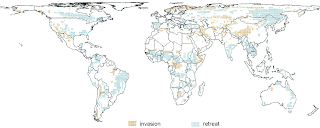
El cambio climático traerá un cambio en la pauta de los incendios a nivel mundial, y estos cambios llegan rápido, según el primer análisis de este tipo, realizado por investigadores de la Universidad de California en Berkeley en colaboración con científicos de la Universidad Tecnológica de Texas.
Los investigadores usaron datos de sensores infrarrojos y térmicos tomados entre 1996 y 2006 por satélites de la Agencia Espacial Europea para su estudio de pirogeografía: la distribución y comportamiento de los incendios, para determinar las características ambientales comunes asociadas con el riesgo de los mismos. Luego han incorporado estas variables en proyecciones acerca de cómo futuros escenarios climáticos, podrán influir en la aparición de los incendios a nivel mundial.
El estudio ha encontrado que gran parte del planeta sufrirá cambios en la actividad incendiaria, y esto implica tanto el aumento como la disminución de la probabilidad de aparición de incendios. Hay áreas en las que raramente se producían incendios en el pasado, que experimentarán un gran aumento de los mismos en el período 2010-2039. Por el contrario, otras regiones donde los fuegos eran comunes en el pasado, serán consideradas como áreas de riesgo en disminución.
Estos estudios preliminares muestran punbtos calientes de aumento en el oeste de los Estados Unidos y en la meseta tibetana, mientras que regiones tales como el noroeste de China o el África central serán menos proclives a los incendios en las próximas décadas.
 Climate change will bring about major shifts in worldwide fire patterns, and those changes are coming fast, according to a first-of-its-kind analysis led by researchers at the University of California, Berkeley, in collaboration with scientists at Texas Tech University.
Climate change will bring about major shifts in worldwide fire patterns, and those changes are coming fast, according to a first-of-its-kind analysis led by researchers at the University of California, Berkeley, in collaboration with scientists at Texas Tech University.Researchers used thermal-infrared sensor data obtained between 1996 and 2006 from European Space Agency satellites in their study of pyrogeography – the distribution and behavior of wildfire – on a global scale. They not only got a global view of where wildfires occur, but they determined the common environmental characteristics associated with the risk of those fires. They then incorporated those variables into projections for how future climate scenarios will impact wildfire occurrence worldwide.
The study has found that much of the planet will incur changes in fire activity, and this includes increases as well as decreases in the likelihood of fire. Specific areas where wildfire occurrence was rare in the past are projected to experience large increases in fire activity in the period 2010-2039. Regions where fire was common in the past and projected to experience a large decrease were considered areas at risk of fire retreat.
These preliminary results show hotspots of fire invasion forming in parts of the western United States and the Tibetan plateau, while regions including northeast China and central Africa may become less fire-prone in the coming decades.
Tomado de/Taken from Science Daily; University of Berkeley
Resumen de la publicación científica/Abstract of the research paper
Krawchuk MA, Moritz MA, Parisien M-A, Van Dorn J, Hayhoe K (2009) Global Pyrogeography: the Current and Future Distribution of Wildfire. PLoS ONE 4(4): e5102. doi:10.1371/journal.pone.0005102
Climate change is expected to alter the geographic distribution of wildfire, a complex abiotic process that responds to a variety of spatial and environmental gradients. How future climate change may alter global wildfire activity, however, is still largely unknown. As a first step to quantifying potential change in global wildfire, we present a multivariate quantification of environmental drivers for the observed, current distribution of vegetation fires using statistical models of the relationship between fire activity and resources to burn, climate conditions, human influence, and lightning flash rates at a coarse spatiotemporal resolution (100 km, over one decade). We then demonstrate how these statistical models can be used to project future changes in global fire patterns, highlighting regional hotspots of change in fire probabilities under future climate conditions as simulated by a global climate model. Based on current conditions, our results illustrate how the availability of resources to burn and climate conditions conducive to combustion jointly determine why some parts of the world are fire-prone and others are fire-free. In contrast to any expectation that global warming should necessarily result in more fire, we find that regional increases in fire probabilities may be counter-balanced by decreases at other locations, due to the interplay of temperature and precipitation variables. Despite this net balance, our models predict substantial invasion and retreat of fire across large portions of the globe. These changes could have important effects on terrestrial ecosystems since alteration in fire activity may occur quite rapidly, generating ever more complex environmental challenges for species dispersing and adjusting to new climate conditions. Our findings highlight the potential for widespread impacts of climate change on wildfire, suggesting severely altered fire regimes and the need for more explicit inclusion of fire in research on global vegetation-climate change dynamics and conservation planning.
No hay comentarios:
Publicar un comentario